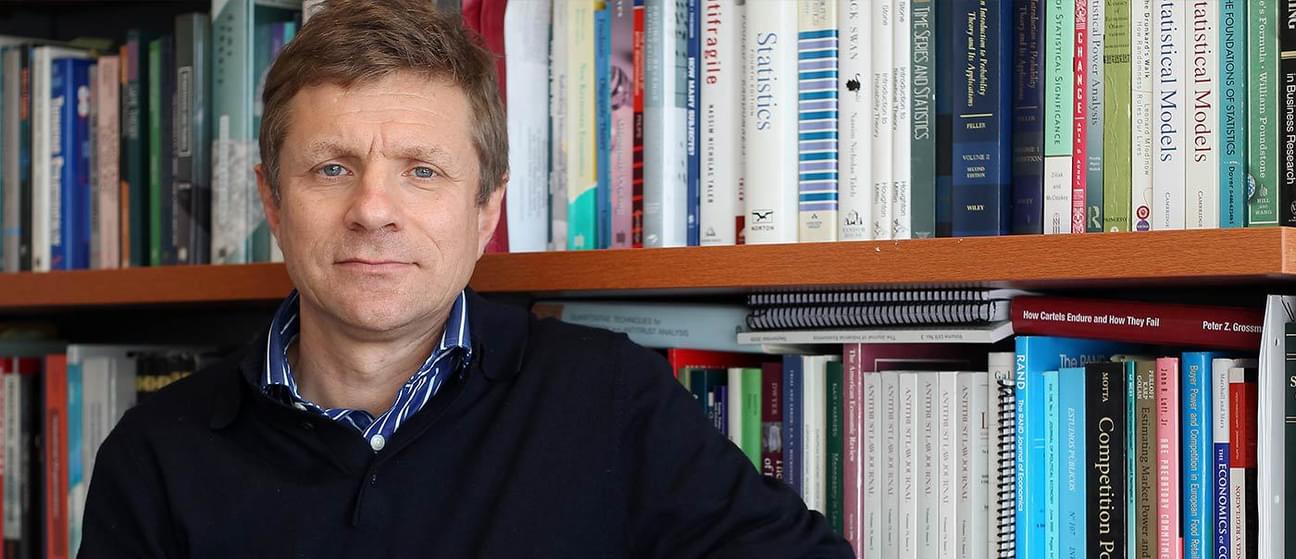Patent Holdout Explains Why Patent Holdup Is Still On The Table: In Memoriam Of Alexander Galetovic

Share
The evidence reported in two empirical papers co-authored by the late Professor Galetovic, showing that all observable implications of the patent holdup theory are inconsistent with the data from the world mobile wireless industry, should have put an end to the debate about the relevance of patent holdup in the SEP context. Yet, the debate lingers on.
In a recent paper in the latest issue of Competition Policy International’s Antitrust Chronicle, Jorge Padilla1 explains that the protracted debate about patent holdup mainly benefits those implementers who engage in patent holdout. As the Latin philosopher Seneca stated once “He has committed the crime who has derived the profit.” It is time to leave behind the debate about holdup and focus on holdout. The implications of patent holdout are not merely distributional, as it is likely to result in under-compensation of innovation, cause the dissipation of social surplus as it leads to excessive litigation, and lead to the exclusion of other implementers which act as willing licensees. Importantly, ex post court-mandated damages are unlikely to deter such a socially costly holdout strategy and compensate patent holders appropriately.
I. Professor Galetovic and the SEP Hold Up Debate
Professor Alexander Galetovic (1965-2022)2 contributed decisively to one of the bitterest intellectual debates I have been involved as an economist; namely, the debate about the theoretical and empirical validity of the claim that owners of standard essential patents (“SEPs”) possess monopoly power and do exploit it in spite of their Fair Reasonable and Non-Discriminatory (“FRAND”) promises – the patent holdup theory.
Since the early 2000s, several authors have raised the alarm about the alleged risk of patent holdup in the licensing of SEPs.3 Some have even assimilated this risk to that posed by climate change.4
Holdup is a classical problem in economics; it arises in circumstances when firms negotiate trading terms after they have made costly, relation-specific investments. Since the costs of these investments are sunk when trading terms are negotiated, they are not factored into the agreed terms. As a result, depending on the relative bargaining power of the firms, the investments made by the weaker party may be under-compensated.5
In the context of SEPs, patent holdup would arise if SEP owners were able to take advantage of the essentiality of their patents to charge excessive royalties to manufacturers of products reading on those patents that made irreversible investments in the standard.6
Those concerned with patent holdup have proposed drastic interventions ranging from reforms of the patent laws to antitrust intervention.7 Those reforms are all directed at reducing patent holders’ leverage in the negotiation with implementers that aim to license their technologies.
Thus, for example, some argue that SEP holders should not be able to seek injunctions,8 though most proposals agree that at least they should be able to do so against unwilling licensees. Of course, a patent holder loses all leverage if it cannot injunct unwilling licenses. Others propose that SEP owners should be compelled to price their patents by reference to the price of the Smallest Saleable Patent Practicing Unit (“SSPPU”) set before any royalties are paid.9 Etc.
All of these proposals are argued with passion on the basis of high level and theoretical arguments about the meaning of the notion of FRAND, the need to promote innovation and hence efficiency, and also on the grounds of equity. Yet, it is obvious that the real goal of these measures is to redistribute rents away from patent holders to the benefit of implementers. A redistribution that could be justified if holdup was indeed a serious problem in practice.
However, after years of heated debate, there is no consensus about whether holdup exists. Some argue that there is no evidence of holdup in practice. If patent holdup were a significant problem, manufacturers would anticipate that their investments would be expropriated and would thus decide not to invest in the first place. But end-product manufacturers have invested considerable amounts in standardized technologies.10
Others claim that while investment is indeed observed, actual investment levels are “necessarily” below those that would be observed in the absence of holdup, if that were possible. They allege that, since that counterfactual scenario is not observable, it is not surprising that more than fifteen years after the patent holdup hypothesis was first proposed, empirical evidence of its existence is still lacking.11
This is where Professor Galetovic entered the debate with a series of articles in which he and his co-authors investigated the empirical relevance of patent holdup in an SEP context using rigorous economic and econometric techniques.
In a first paper titled “An Empirical Examination of Patent Hold-Up,”12 co-authored with Professors Stephen Haber and Ross Levine, he sought to evaluate two key predictions of the SEP hold-up theory.
- First, that industries featuring SEPs (or SEP-reliant industries), such as the smartphone industry, should experience more stagnant quality-adjusted prices than similar non-SEP-reliant industries, such as watches, electricity, computers, etc..
- Second, that court decisions that reduce the excessive power of SEP holders should accelerate innovation in SEP-reliant industries.
They found no empirical support for either proposition. On the contrary, they found that SEP-reliant industries exhibited the fastest quality-adjusted price declines in the U.S. economy.
Later, in a paper titled “The Case of the Missing Royalty Stacking in the World Mobile Wireless Industry,”13 co-authored with Dr Kirti Gupta, he showed that all observable implications of the patent holdup theory are inconsistent with the data from the world mobile wireless industry.
They found that, in sharp contrast with the theory’s predictions, between 1994 and 2013, worldwide yearly device sales grew 62-fold, at an average rate of 20.1 percent per year, and both selling and quality-adjusted prices fell fast over time despite the large increase in the number of SEP holders, each of which is alleged to enjoy monopoly power.
They also found that theory predicts royalty yields which are more than an order of magnitude larger than the observed average cumulative royalty yield charged by SEP holders in practice.
In my opinion, these two papers, which to the best of my understanding remain uncontested, should have put an end to the debate about the relevance of patent holdup in the SEP context. Yet, as all of those familiar with the SEP world know, it has not.14 Why? I have no clear-cut answer to this question. But I can answer one that is closely related and can shed light on the former: Who benefits?
II. Patent Hold-Out Explains The Persistence Of The Patent Holdup Theory
The persistent debate about patent holdup benefits those implementers engaging in patent holdout, euphemistically referred to as “efficient infringement.”15 As Epstein & Noroozi (2017) explain,16
By “patent holdout” we mean [...] that an implementer refuses to negotiate in good faith with an innovator for a license to valid patent(s) that the implementer infringes, and instead forces the innovator to either undertake significant litigation costs and time delays to extract a licensing payment through court order, or else to simply drop the matter because the licensing game is no longer worth the candle.
Unlike patent holdup, patent holdout is ubiquitous.
Patent holdout is particularly worrisome in the standardization context, since SEP owners, limited in their ability to request an injunction in case of patent infringement, have little or no leverage when negotiating a licensing deal.
The risk of holdout is more significant for SEP owners with many complementary patents reading across jurisdictions, since implementers typically challenge the validity and/or essentiality of SEP portfolios “patent-by-patent” and “jurisdiction-by-jurisdiction,”17 which makes patent enforcement costly and inefficient.18
The former head of patent licensing at Apple, Boris Teksler, explained that in his opinion “‘efficient infringement,’ where the benefits outweigh the legal costs of defending against a suit, could almost be viewed as a ‘fiduciary responsibility,’ at least for cash-rich firms that can afford to litigate without end.”19
Heiden & Petit (2017) empirically document that some implementers do engage in patent holdout by ignoring correspondence, postponing negotiations, or simply by making counteroffers that are inconsistent with industry practice.20 Other strategies include trying to affect the policies of SSOs or appealing to competition authorities. Of course, by delaying and stalling negotiations, potential licensees aim to obtain better licensing terms.
Heiden & Petit argue that the delay and the costs associated to patent holdout may also be related to the significant decrease in licensing coverage in the mobile phone industry that has dropped from 73 percent to 36 percent between 2006 and 2016.
Some scholars, such as Shapiro & Lemley (2020),21 disagree and claim that the patent holdout concern is a theoretical and groundless “chimera,” which at most affects only the distribution of surplus from innovation, stating that, in any case, it could be addressed through ex post court-mandated damages.
According to these authors, “[p]atent advocates have sought to deflect concerns about patent holdup not only by denying its existence but by concocting a supposedly parallel story of ‘patent holdout.’” They claim that “[p]atent holdout is incoherent as a theoretical matter and rejected as an empirical matter” and conclude that “[t]hose who express concerns about patent holdout seem to want to increase the returns to patent holders whose inventions add little or no incremental value, possibly because they advise SEP owners.”22
Leaving aside the unnecessary innuendo,23 what they aver is that when an implementer takes actions to stop paying licensors, such a strategy may harm patent owners, though they can always be compensated in court; but does not harm consumers, because the latter’s slice of the pie is unchanged; nor those competitors paying for the use of the innovator’s technologies.
Yet, as explained by Llobet & Padilla (2021), patent holdout can engender significant social-welfare losses under a wide range of realistic
circumstances.24
They explain the reasons why the implications of patent holdout are not merely distributional. Implementers have the incentive to incur significant costs to litigate SEPs patent-by-patent and/or jurisdiction-by-jurisdiction when this is socially inefficient to lower royalty payments.
This may result in under-compensation of innovation, cause the dissipation of social surplus as it leads to excessive litigation, and lead to the exclusion of other implementers which, due to their smaller size or because of their start-up nature, cannot afford to engage in a similar litigation strategy.
Importantly, ex post court-mandated damages are unlikely to deter such a socially costly holdout strategy and compensate patent holders appropriately.
- Firstly, if the cost of a patent holdout strategy is payment of reasonable royalties ex post, then (rational) implementers will have no incentive to pay early, given that a dollar today is worth more than a dollar in the future.
- Secondly, when all that the SEP holder can recover in adjudication is cash royalties, not the other terms and conditions (e.g. a cross license) that would have been able to obtain during good-faith bilateral negotiations, then an injunction is strictly needed to make the SEP holder whole.
- Finally, when a delay in payment causes the SEP holder’s bankruptcy or undermines its ability to fund valuable R&D, either by drying its own internal funds or weaking its credit relative to third-party investors, then an injunction may also be strictly needed.25
III. Cui Prodest Scelus, Is Fecit 26
The late Professor Galetovic co-authored two papers employing state-of-the art economic and econometric tools that show that all observable implications of the patent holdup theory are inconsistent with the data from the world mobile wireless industry.
Following those contributions and unless anyone shows that those studies are wrong or presents evidence pointing in the opposite direction, the debate about the relevance of patent holdup in the SEP context should be over. Yet, it lingers on. In my opinion, this is because it is in the interest of those engaging in patent holdout to keep the debate alive.
This strategy, while privately rational, is socially costly, because patent holdout is likely to result in under-compensation of innovation, cause the dissipation of social surplus, as it leads to excessive litigation, and lead to the exclusion of other implementers which act as willing licensees.
It is time for regulators and competition policy agencies to adopt an evidence-based approach when dealing with SEP disputes. If they do so, they should realize that patent holdup is a distraction. As a former colleague and co-author once told me: “We may trust in God but from everyone else we should demand data.”
1 Jorge Padilla is Senior Managing Director at Compass Lexecon. Jorge has been involved in numerous disputes, typically representing SEP owners, dealing with the valuation of SEPs as well as the compatibility of unilateral conduct with the antitrust laws in the European Union, China, Japan, Korea, Taiwan, and the United States. From 2018 to 2020, he was member of the Expert Group on the Licensing and Valuation of Standard Essential Patents created by the European Commission. The opinions in this document are the author’s sole responsibility and do not necessarily represent the views of other Compass Lexecon colleagues or those of Compass Lexecon’s clients.
2 See https://www.hoover.org/profile....
3 See Justus Baron et al.: Contribution to the Debate on SEPs. European Commission - Internal Market, Industry, Entrepreneurship and SMEs - Industrial policy: Standard Essential Patents (2021), available at https://ssrn.com/abstract=3778....
4 See e.g. Carl Shapiro & Mark A. Lemley: The Role of Antitrust in Preventing Patent Holdup, 168 U. PENN. L. REV., 2019, 2063 (2020).
5 See Oliver Williamson: Markets and Hierarchies: Analysis and Antitrust Implications, Free Press: New York, (1975).
6 See Mark A. Lemley & Carl Shapiro: Patent Holdup and Royalty Stacking, 85 TEX. L. REV., 1991, 2049 (2007).
7 See e.g. Rebecca Kelly Slaughter: SEPs, Antitrust, and the FTC, Remarks Prepared for Delivery1 ANSI World Standards Week: Intellectual Property Rights Policy Advisory Group Meeting (October 29, 2021.) See also Carl Shapiro & Mark A. Lemley (2020), op. cit.
8 See Mark A. Lemley & Carl Shapiro (2007), op. cit. See also Carl Shapiro, Injunctions, Hold-Up, and Patent Royalties,12 AM. L. &ECON. REV. 280, 282 (2010), and Greg Sidak, The Meaning of Frand, Part II: Injunctions, J. COMP. L. & ECON., 11(1), 201–269 (2015).
9 See Timothy Syrett, The SSPPU is the Appropriate Royalty Base for FRAND Royalties for Cellular SEPs, IPWatchdog, (2021), available at https://www.ipwatchdog.com/202....
10 See Keith Mallinson, Mallinson on Patent Holdup and Holdout: for IP Finance 16th August 2016, available at https://www.wiseharbor.com....
11 See Carl Shapiro & Mark A. Lemley (2020), op. cit.
12 Alexander Galetovic, Stephen Haber & Ross Levine, An Empirical Examination of Patent Hold-Up, J. COMP. L. & ECON., 11(3), 549–578 (2015).
13 Alexander Galetovic & Kirti Gupta, The Case of the Missing Royalty Stacking in the World Mobile Wireless Industry, IND. & CORP. CHANGE, 29(3) (2020).
14 To keep abreast of what is going on in the SEP world, visit Florien Mueller‘s FOSS patents blog, available at http://www.fosspatents.com/. I am not always sharing his views, though sometimes I do, but I know of no better way of keeping informed about recent developments concerning patent licensing in standardized industries.
15 Efficient in a private, self-interested sense, not in the collective interest, of course.
16 See Richard A. Epstein & Kayvan B. Noroozi: Why Incentives for “Patent Holdout” Threaten to Dismantle FRAND, And Why It Matters, 32 BER. TECH. L. J., 1381, 1431 (2017).
17 See Justus Baron et al.: Contribution to the Debate on SEPs. European Commission - Internal Market, Industry, Entrepreneurship and SMEs - Industrial policy: Standard Essential Patents (2021), available at https://ssrn.com/abstract=3778....
18 In the Unwired Planet vs Huawei case, [2017] EWHC 2988 (Pat), Judge Birss asked “[W]hat sort of license for Unwired Planet’s portfolio would be FRAND in terms of its geographical scope when applied to a multinational licensee like Huawei? I will start by asking what a willing licensor and a willing licensee with more or less global sales would do. There is only one answer. Unwired Planet’s portfolio today is (and in 2014 it was) sufficiently large and has sufficiently wide geographical scope that a licensor and licensee acting reasonably and on a willing basis would agree on a worldwide license. They would regard country by country licensing as madness. A worldwide license would be far more efficient.”
19 See The Trouble with Patent-Troll Hunting, The Economist (Dec. 14, 2019), available at https://www.economist.com/busi....
20 See Bowman Heiden & Nicolas Petit: Patent ‘Trespass’ and the Royalty Gap: Exploring the Nature and Impact of Patent Holdout, 34 SANTA CLARA HIGH TECH. L. J., 179, 249 (2017). See also Brian J. Love & Christian Helmers, An Empirical Test of Patent Hold-out Theory: Evidence from Litigation of Standard Essential Patents, SANTA CLARA UNIV. LEGAL STUDIES RESEARCH PAPER, (2021), available at https://ssrn.com/abstract=3950.... The authors find some evidence of an association between inlitigation hold-out and both SEP portfolio size and patent quality; however, they find no evidence associating pre- or in-litigation hold-out with the international breadth of SEP rights.
21 Carl Shapiro & Mark A. Lemley: The Role of Antitrust in Preventing Patent Holdup, 168 U. PENN. L. REV., 2019, 2063 (2020).
22 See Shapiro & Lemley (2020), op. cit., footnote 91.
23 See footnote 1 above for a statement of interest.
24 See Gerard Llobet & Jorge Padilla: A Theory of Socially Inefficient Patent Holdout, CEMFI, (2021), available at https://papers.ssrn.com/sol3/papers.cfm?abstract_id=4021461.
25 David Goldman: Qualcomm made a deal with Apple. Its stock has soared 40 percent, CNN Business (April 17, 2019), available at https://edition.cnn.com/2019/0.... “With the company no longer at risk of losing one of its most important sources of revenue, Qualcomm’s stock has soared 40% to a 5-year high since it announced Tuesday it had settled all litigation with Apple. Qualcomm will continue charging Apple royalties for its patents, and Apple will pay Qualcomm a substantial fee as part of the agreement.”
26 He has committed the crime who has derived the profit
This paper was originally published by Competition Policy International and is available on their website with a subscription. The views expressed are those of the authors only and do not necessarily represent the views of Compass Lexecon, its management, its subsidiaries, its affiliates, its employees, or clients.


